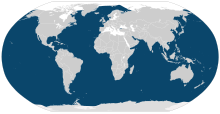Humpback whale
A humpback whale (Megaptera novaeangliae) is a large baleen whale with long flippers and a knobbly head. They can be found in every ocean.[3]
| Megaptera Megaptera novaeangliae[1] Temporal range:
| |
|---|---|

| |

| |
| Size compared to an average human | |
| Scientific classification | |
| Domain: | Eukaryota |
| Kingdom: | Animalia |
| Phylum: | Chordata |
| Class: | Mammalia |
| Order: | Artiodactyla |
| Infraorder: | Cetacea |
| Family: | Balaenopteridae |
| Genus: | Megaptera Gray, 1846 |
| Species: | M. novaeangliae
|
| Binomial name | |
| Megaptera novaeangliae Borowski, 1781
| |

| |
| Humpback whale range | |
| Synonyms | |
| |
They can grow to 15–16 m (49–52 ft) long and weigh up to 40 metric tons.
Life history
changeHumpback whales can live up to 45 years. [4] They migrate between the places they feed in the winter and the places they give birth in the summer. They usually live alone.
Feeding
changeHumpback whales eat krill and small fish, for example herring, capelin, and sand lance. They scoop up their food in their large mouths. Sometimes they round up their prey by swimming in tight circles and blowing curtains of bubbles around them. They often hunt in small groups, called pods.
Whale song
changeThe male whale is known to sing for up to 22 hours at a time. Because whales do not have vocal cords, they make songs by forcing air through their nasal passages. Every male has a different song. We don't yet know why they sing, it might be to call a female or scare away other males. The songs are made up of a pattern of low notes repeated over a period of hours or days. The whales slowly change their songs over a period of years.[5]
Other sounds
changeBoth the male and female humpback whales make other sounds, such as moans and grunts, to communicate with each other.
References
change- ↑ Mead, J.G.; Brownell, R. L. Jr. (2005). "Order Cetacea". In Wilson, D.E.; Reeder, D.M (eds.). Mammal Species of the World: A Taxonomic and Geographic Reference (3rd ed.). Johns Hopkins University Press. ISBN 978-0-8018-8221-0. OCLC 62265494.
- ↑ "Fossilworks: Megaptera". Fossilworks. Archived from the original on 2018-04-09. Retrieved 2018-04-08.
- ↑ Reilly, S.B., Bannister, J.L., Best, P.B., Brown, M., Brownell Jr., R.L., Butterworth, D.S., Clapham, P.J., Cooke, J., Donovan, G.P., Urbán, J. & Zerbini, A.N. (2008). "Megaptera novaeangliae". IUCN Red List of Threatened Species. Version 2012.2. International Union for Conservation of Nature. Retrieved 18 January 2013.
- ↑ Chapham, Phillip J.; Mead, James G. (1999). "Megaptera novaeangliae". Mammalian Species 604: 1–9.
- ↑ Thomas Ling (June 22, 2021). "How humpback whales communicate through a hidden global network of song". BBC Science Focus Magazine. Retrieved July 7, 2021.
